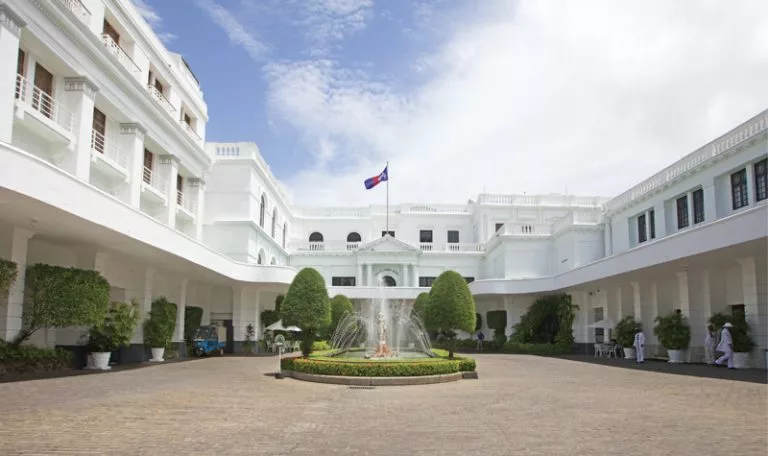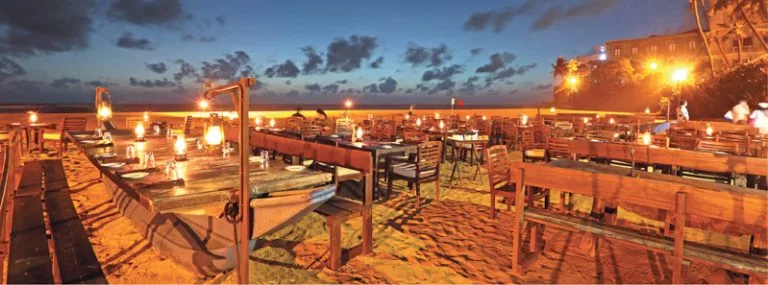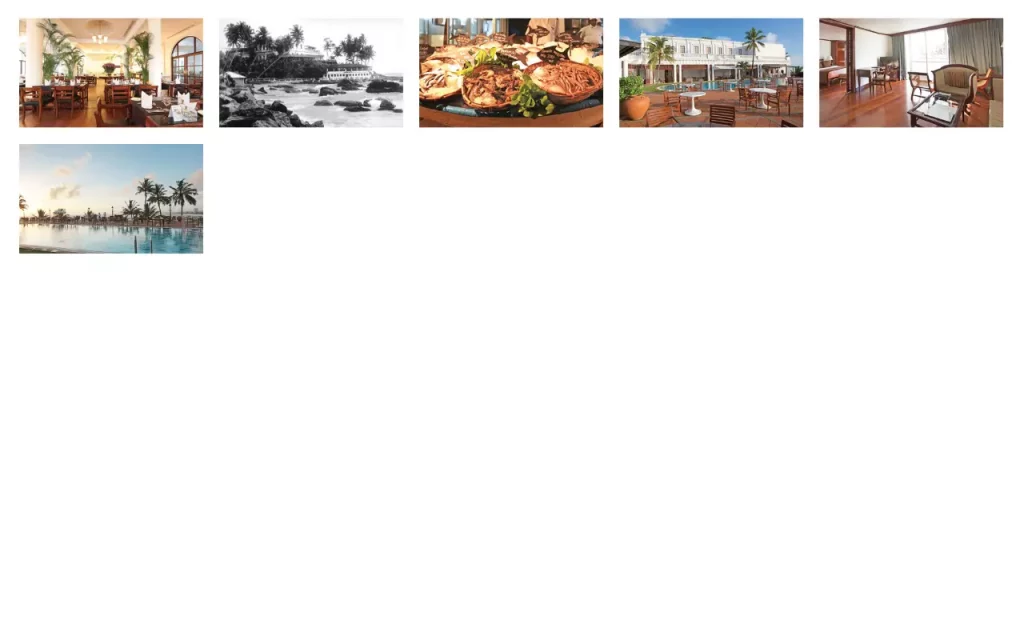
If you would prefer to stay in a colonial heritage hotel that not only has outstanding facilities and service in a near-perfect setting but also some history worth exploring – with a romantic legend attached – then make your way to the Mount Lavinia Hotel.
Words Richard Boyle | Photographs Menaka Aravinda

Sir Thomas Maitland (1805-1811), the second British Governor of Ceylon, was, on his arrival, dissatisfied with his official residence, the Dutch-built King’s House in Fort. So he took the finely-shaded path south (today’s sun -scorched Galle Road) in quest of a slice of paradise. After seven miles (12 km) he encountered, near the village of Galkissa, an imposing headland, Lihiniyagala, which divided a lengthy, idyllic golden beach and overlooked a more dramatic rock-strewn and choppy bay.
On choosing this delightful location for his new residence, Maitland could not have foreseen that 210 years later, in 2016, his fine judgement would be enjoyed by tens of thousands of visitors from around the world, staying in a splendid hotel that has at its heart the site of his ‘bungalow-on-the-promontory’, which he named “Mount Lavinia House”.
The book Mount Lavinia: The Governor’s Palace (2nd edition, 2016) examines in detail the history and architecture of the building.
Maitland’s Mount Lavinia House
Maitland, in building his residence in 1806, adopted the classical mode of architecture of the colonial era, and the 35-acre (14-hectare) grounds contained offices and a barracks. Maria Graham, the first British lady traveller to visit Mount Lavinia House in 1810, and to describe it in Journal of a Residence in India (1812), also conveys the surrounding tropical bliss that sharply contrasts with today’s urbanity:
“The interior, though not large, is very pleasant; a long gallery looks towards the sea; the rooms on the other side command some pretty hills, the slopes of which form fine lawns; and in the valley are palm-trees, which hide all the farm-offices, and afford shelter to animals of the deer and elk kind.”
Legend has it that Maitland became spellbound by a half-Portuguese half-Sinhalese dancer, Lovina Aponsuwa, who lived in Galkissa. The local dance troupe to which she belonged gave frequent performances for Maitland. They became lovers, and an underground passage was dug from a disused well near Lovina’s house to Maitland’s cellars so that their potentially scandalous romance remained clandestine.
Perhaps Maitland named his residence in honour of his lover, but there are other theories regarding the origin of “Mount Lavinia”. Most prevalent is that it stems from Lihiniyagala, “seagull rock”. Another suggests it is derived from a herb, known to the Sinhalese as lavenia (Adenostemma viscosum).
A governorship lasted about six years, thus in 1811 Maitland, in poor health anyway, was recalled from Ceylon. Unable to take Lovina with him, the couple never met again, but Maitland is said to have gifted her some land. It is frustrating this romantic story remains a legend, though some in Mount Lavinia claim to be Lovina’s relatives. And her ghost, others say, dressed in long sleeves and sometimes dancing, has been seen at the hotel and a local school.
After two subsequent governors had utilized Mount Lavinia House, their successor, Sir Edward Barnes (1824-1831), found that inferior materials, voracious insects, intense rain, tropical sunlight, and constant sea spray, had resulted in severe damage to the building within two decades of its completion.
Barnes’ Mount Lavinia House
In 1824, Barnes began the construction of a new, two-storey Mount Lavinia House after demolishing Maitland’s building. Over the foundations, Barnes’ designer and builder, Captain Sanderson of the Royal Engineers, created an Italianate villa, usually formed, as it was at Mount Lavinia, of a central block with wings. Sanderson, untrained in neo-classical architecture, nevertheless used to perfection the ‘masculine’ Doric order of columns on the ground floor to support the ‘feminine’ Ionic order on the first floor with their distinct scroll-type decoration at the top.
Abandoned as the Governor’s residence after The Pavilion was constructed in Kandy, Mount Lavinia House became a military sanitarium, was then sold by the government, and after several private ownerships and a spell as a boarding house, opened as a hotel in 1877.

The Mount Lavinia Hotel
Initially called “The Mount Lavinia Grand Hotel”, it commenced business at an opportune time when Colombo would soon replace Galle as the Island’s passenger port. Mount Lavinia, as the area was now called, became not just an agreeable place to stop during the stagecoach journey from Galle to Colombo, but a fashionable destination for a short sojourn or day excursion whilst in the capital.
Today, those who arrive at the Mount Lavinia Hotel to stay, or just visit to experience the food and ambience, will discover when they pass through an avenue of imposing royal palms the gleaming white façade of the old part of the building. At the entrance driveway, witness the statue of Lovina rising from a rectangular pool and serenaded by encircling fountains.
Appreciate the remains of Barnes’ 1824 villa, for the original building still forms the centre of the hotel. Explore the original entrance to the Governor’s residence and continue up the steep staircase to the banqueting hall (popular for weddings), the hotel’s foremost gastronomic venue the Governor’s Restaurant, and the voluminous corridors, columns, attractively-tiled floors, and abundance of wood-panelling.
As far as the legend is concerned, beyond the reception is Maitland’s wine cellar, which survived the demolition and contains the entrance to the ‘tunnel of love’, bricked up in 1920.
Step onto The Terrace with its swimming pool and eponymous restaurant and take in the stunning views of a curved beach and a hazy Colombo in the distance. Little wonder it was designated by Newsweek magazine in 2000 as one of the “World’s Best Gathering Places”. The hotel plays a role in film history, for the Oscar-laden Bridge on the River Kwai was partly shot there in 1957. Other actors who have stayed during different productions include Vivien Leigh, Kirk Douglas and Gregory Peck. Characters as diverse as the cosmonaut Yuri Gagarin and playwright and novelist Somerset Maugham have also graced the hotel.
In 1975, the ownership of the hotel passed into the hands of the Ukwatte family under the helm of Mr U K Edmund. Since then considerable improvements have been accomplished, including the addition of two wings to the existing Colonial Wing: the Sea and Garden Wing completed in 1978, and the Bay Wing in 1980. The present Chairman, Sanath Ukwatte has continued to improve the hotel.
Many of the 210 rooms have an elevated view of the ocean, such as that experienced on a ship. A 19th-century wag commented: “Staying at Mount Lavinia Hotel has all the advantages of a sea trip without the discomforts.” Nevertheless, you cannot enjoy the pleasures of a tropical beach on a ship! Fortunately, to the south of the promontory the hotel has a pristine 200 metre-long private beach, where the Sea Cove restaurant is located.
North of the hotel is the public Mount Lavinia Beach with its adjacent restaurants on the edge of the sand, similar to Hikkaduwa and Unawatuna, which specialise in dishes made from fresh local seafood. However, Mount Lavinia Beach is most renowned for its relaxed nighttime atmosphere.
The Mount Lavinia Hotel preserves an essential architectural example of Sri Lanka’s colonial heritage, and Barnes’ villa and the lover’s tunnel beneath (which almost proves this was no legend), continue to fascinate visitors, who tend to return.



